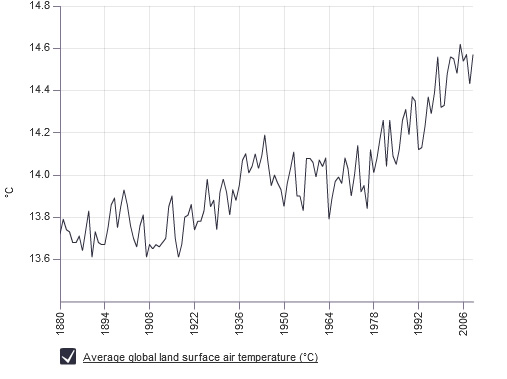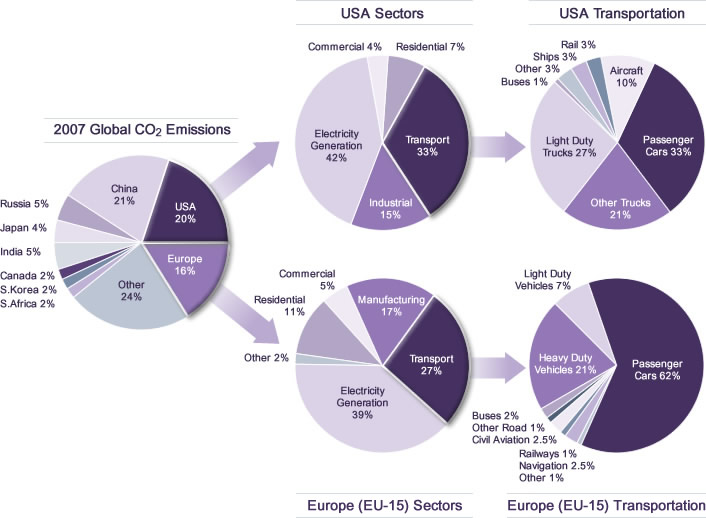-
MATERIAL ISSUES
- Materiality Analysis
-
Climate Change
- Climate Change: Related Commitments and Progress
- Greenhouse Gas Emissions Overview
- Climate Change Risks and Opportunities
- Our Strategy: Blueprint for Sustainability
- Ford's Sustainable Technologies and Alternative Fuels Plan
- Progress and Performance
- Climate Change Policy and Partnerships
- Electrification: A Closer Look
- Mobility
- Human Rights
- Vehicle Safety
- Sustaining Ford
- Perspectives on Sustainability
Toolbox
Greenhouse Gas Emissions Overview
Climate change is the result of an increase in heat-trapping (greenhouse) gases in the atmosphere. Carbon dioxide (CO2) is the major long-lived greenhouse gas (GHG). The burning of fossil fuels (to provide electricity, heat and transportation, and to support industry and agriculture), as well as deforestation, lead to emissions of CO2 and increased levels of atmospheric CO2 (see Figure 1).
There has been discussion recently in the media regarding the integrity of the temperature record. Specifically, it has been claimed that climate scientists at the Climate Research Unit (CRU) at the University of East Anglia in the UK have misrepresented the instrumental temperature record. This has become known as "Climategate." We do not believe these developments undermine the broad scientific basis for concern about climate change. Indeed, we continue to monitor original research and discussion pertaining to climate change and support the vigorous application of the scientific method in this and other fields of inquiry. We also note that the temperature record independently reported by scientists at the National Aeronautics and Space Administration (NASA) shows a distinct warming trend. As seen in Figure 2, the past decade was the warmest decade in the instrumental temperature record. Moreover, independent measurements of an increase of sea level and ocean acidification are consistent with the impact of rising GHG concentrations and global temperature.
Figure 1: CO2 concentration measured at the observatory in Mauna Loa, Hawaii
Data source: NOAA (2010)
Figure 2: Global temperature

Data source: NASA (2010)
Global CO2 Emissions
Figure 3 (below) provides a breakdown of estimated 2007 fossil fuel CO2 emissions by region. For the United States and Europe, the emissions are further broken down by sector and by mode in the transportation sector. The data were taken from reports published by the International Energy Agency, European Environment Agency and U.S. Environmental Protection Agency. Globally, emissions from cars and light-duty trucks comprise about 11 percent of all fossil fuel CO2 emissions. In the United States, cars and light-duty trucks account for approximately 20 percent of fossil fuel CO2 emissions, or approximately 4 percent of global fossil fuel CO2 emissions. In Europe, passenger cars and light-duty trucks account for approximately 19 percent of fossil fuel CO2 emissions, or about 3 percent of global fossil fuel CO2 emissions.
Until recently, the United States was the largest CO2 emitter. In 2007, however, emissions from China surpassed those from the United States. It is expected that the gap between emissions from China and the United States will widen in the future, although per-capita emissions of CO2 in the U.S. remain higher (by approximately a factor of four) than those in China.
Figure 3: Distribution of Fossil Fuel CO2 Emissions 2007

Life-Cycle Vehicle Emissions
The GHG emissions attributable to Ford's activities include emissions from our facilities, from the transportation of our products and people, from the vehicles we produce once they are in use by customers, and from our suppliers. In this report, we provide data on CO2 emissions from our facilities and our U.S. and European new products. Additional information on our GHG footprint is found in the Life-Cycle Vehicle CO2 Emissions section.
Most of the life-cycle CO2 emissions from vehicles are released when the vehicles are driven, rather than when they are manufactured, maintained or recycled at end-of-life. As vehicle fuel efficiency improves and lower-carbon fuels are made available, we expect that the relative contribution of CO2 emissions from the fuel-consumption phase will decrease (see Life-Cycle Vehicle CO2 Emissions).
Greenhouse Gas Emissions Snapshot
In 2001, we estimated the greenhouse gas emissions from our operations and products as part of an assessment of the impact of the climate change issue on our Company. We updated this estimate for our 2006/7 report. Many assumptions were required to generate the estimate, and we do not control all of the factors that influence its magnitude. Therefore, we do not use this estimate as an ongoing performance measure. We intend to continue to reduce our facility GHG emissions, improve the energy efficiency of our operations and the vehicles we sell, closely track those results and update the estimate in the future.
Supply Chain
We are currently evaluating climate change risks and opportunities across our supply chain and searching for new opportunities and relationships that will enhance supplier environmental performance. (See the Progress and Performance section for details of our participation in initial efforts to assess GHG emissions in our supply chain.) Within the Aligned Business Framework agreement with suppliers, environmental leadership is integral to overall business performance metrics. Climate-change-related activities are highlighted as potential leadership opportunities. In addition, our requirement that suppliers implement robust environmental management systems will better enable them to understand, measure and report their emissions. We also will seek out opportunities to partner with suppliers to improve the greenhouse gas emissions performance of our products and processes, and improve energy efficiency throughout the vehicle life-cycle, including in the supply chain.
Beyond CO2
We have a holistic view of climate change and have addressed non-CO2 long-term greenhouse gases such as hydrofluorocarbons (HFCs), perfluorocarbons (PFCs), nitrous oxide (N2O) and sulfur hexafluoride (SF6). We have prohibited SF6 in tires and PFCs in open systems since 1999. We have conducted scientific research to determine the relative contribution of a wide range of long-lived greenhouse gases to radiative forcing of climate change and have published our results to reduce uncertainties in the scientific assessments. We are working with our suppliers to optimize air conditioning efficiency, reduce refrigerant leakage rates and investigate alternatives. We are also actively conducting research to evaluate the environmental fates of potential alternative air conditioning refrigerants that may replace HFC-134a and have made our research data available to the scientific community. Scientific reports on the environmental impact of hydrofluoroolefins as potential replacements for HFCs have been published in peer-reviewed scientific literature. We prohibited the use of SF6 in magnesium casting as of January 2004 through our Restricted Substance Management Standard. Given the impressive reductions in the emission of criteria pollutants (hydrocarbons, NOx, particulate matter and carbon monoxide) enabled by improvements in engine and exhaust after-treatment technology, we believe that the contribution to climate change by such short-lived pollutants from light-duty vehicles will be of relatively minor importance in the future.1
While carbon dioxide is by far the most important greenhouse gas associated with the use of motor vehicles, small amounts of other greenhouse gases are also emitted, notably methane (CH4), N2O and HFC-134a. A small amount of methane is formed in the engine and emitted into the atmosphere. We have assessed the contribution to climate change made by methane emissions from vehicles as about 0.3 to 0.4 percent of that of the CO2 emissions from vehicles. We have assessed the contribution to climate change from N2O emissions from vehicle tailpipes (not including potential emissions associated with fuel production) as about 1 to 3 percent of that of the tailpipe CO2 emissions from vehicles. Finally, we have estimated that the radiative forcing contribution of HFC-134a leakage from an air-conditioner-equipped vehicle is approximately 3 to 5 percent of that of the CO2 emitted by the vehicle.2 When expressed in terms of "CO2 equivalents," the contribution of vehicle emissions to radiative forcing of climate change is dominated by emissions of CO2.
T.J. Wallington, J.E. Anderson, S.A. Mueller, S. Winkler, and J.M. Ginder, "Emissions omissions," Science, 327, 268, (2010).
T. J. Wallington, J. L. Sullivan, and M. D. Hurley, "Emissions of CO2, CO, NOx, HC, PM, HFC-134a, N2O and CH4 from the Global Light Duty Vehicle Fleet," Meteorol. Z., 17, 109 (2008).